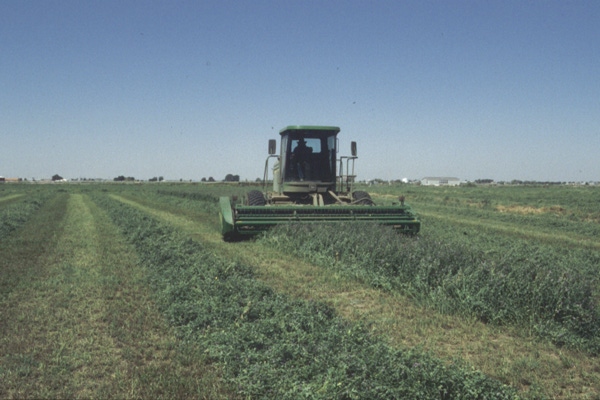
Roundup Ready (RR) alfalfa technology adds a tool to the weed control arsenal but there are tradeoffs in using it.In warmer areas of Arizona, growers may be able to justify the increased seed cost through higher quality hay and extended stand life.Growers in cooler parts of Arizona may not be able to economically justify the greater seed cost of RR alfalfa.
October 18, 2011

Glyphosate-resistant alfalfa (Roundup Ready or RR alfalfa) can be planted in Arizona following the USDA-APHIS decision in January 2011 to grant it non-regulated status. This technology adds a tool to the alfalfa weed control arsenal but there are tradeoffs in using it.
A healthy, vigorous alfalfa stand will suppress weeds. Growers in cooler parts of Arizona frequently do not need to use herbicides after establishment, because cutting and alfalfa competition suppress weeds. These growers may not be able to economically justify the greater seed cost of RR alfalfa.
In warmer areas of Arizona, summer temperatures are higher than optimum for alfalfa growth, and weeds including purple nutsedge and barnyardgrass compete with alfalfa. Growers in these areas may be able to justify the increased seed cost through higher quality hay and extended stand life.
Weed control during stand establishment is critical to assure a uniform, high density distribution of alfalfa plants that will maximize yield and quality. Due to the polyploid genetics of alfalfa, 3 percent to 7 percent of seedlings will not contain the RR gene.
For weed control and to remove non-RR plants, the best time to apply glyphosate is at the 3–4 trifoliate leaf growth stage. Apply 0.75–1.5 pounds active ingredient per acre of glyphosate. Our field research showed this early application was sufficient given the competitive nature of alfalfa to provide weed control up to the first cutting in the spring following fall planting.
A second application may be made up to five days before the first cutting.
RR alfalfa may be treated with glyphosate at rates of 0.75–1.5 pounds active ingredient/acre per application; sequential applications should be at least seven days apart. The combined total of all in-crop glyphosate applications per calendar year may not exceed 4.64 pounds active ingredient/acre.
Potential glyphosate rates and numbers of applications per year are: five applications at 0.93 pounds active ingredient/acre, four applications at 1.16 pounds active ingredient/acre, and three applications at 1.54 pounds active ingredient/acre, or 26, 33, and 44 fluid ounces an acre of a 4.5 pound active ingredient/gallon glyphosate formulation.
Research in western Arizona on purple nutsedge found that multiple applications at 1.16 pounds active ingredient/acre provide better control than fewer applications at 1.54 pounds active ingredient/acre. Often it is advantageous to use other post-emergence and pre-emergence herbicides to manage weeds in alfalfa.
As an alfalfa stand ages and density declines due to natural self-thinning, devote more attention to weed management to maintain quality.
Click on this link, http://ag.arizona.edu/crops/cotton/files/RR-alfalfaShortF.pdf, for the related tables and photos with this article.
You May Also Like



